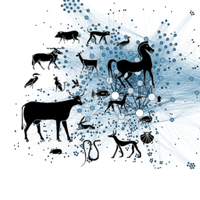Determining insulin sensitivity from glucose tolerance tests in Iberian and Landrace pigs
This article has been Reviewed by the following groups
Discuss this preprint
Start a discussion What are Sciety discussions?Listed in
- Evaluated articles (PeerJ)
- Evaluated articles (Peer Community in Animal Science)
- Articles that showcase interesting usage of Sciety (BlueReZZ)
Abstract
As insulin sensitivity may help to explain divergences in growth and body composition between native and modern breeds, metabolic responses to glucose infusion were measured using an intra-arterial glucose tolerance test (IAGTT). Iberian (n = 4) and Landrace (n = 5) barrows (47.0 ± 1.2 kg BW), fitted with a permanent carotid artery catheter were injected with glucose (500 mg/kg BW) and blood samples collected at −10, 0, 5, 10, 15, 20, 25, 30, 45, 60, 90, 120 and 180 min following glucose infusion. Plasma samples were analysed for insulin, glucose, lactate, triglycerides, cholesterol, creatinine, albumin and urea. Insulin sensitivity indices were calculated and analyed. Mean plasma glucose, creatinine and cholesterol concentrations were lower ( P < 0.01) in Iberian (14, 68 and 22%, respectively) compared with Landrace pigs during the IAGTT. However, mean plasma insulin, lactate, triglycerides and urea concentrations were greater ( P < 0.001) in Iberian (50, 35, 18 and 23%, respectively) than in Landrace pigs. Iberian pigs had larger area under the curve (AUC) of insulin ( P < 0.05) and lactate ( P < 0.1), and smaller ( P < 0.05) AUC for glucose 0-60 min compared with Landrace pigs. Indices for estimating insulin sensitivity in fasting conditions indicated improved β-cell function in Iberian compared with Landrace pigs, but no difference ( P > 0.10) in calculated insulin sensitivity index was found after IAGTT between breeds. A time response ( P < 0.05) was obtained for insulin, glucose and lactate so that maximum concentration was achieved 10 and 15 min post-infusion for insulin (Iberian and Landrace pigs, respectively), immediately post-infusion for glucose, and 20 min post-infusion for lactate, decreasing thereafter until basal levels. There was no time effect for the rest of metabolites evaluated. In conclusion, growing Iberian pigs challenged with an IAGTT showed changes in biochemical parameters and insulin response that may indicate an early stage of insulin resistance.



